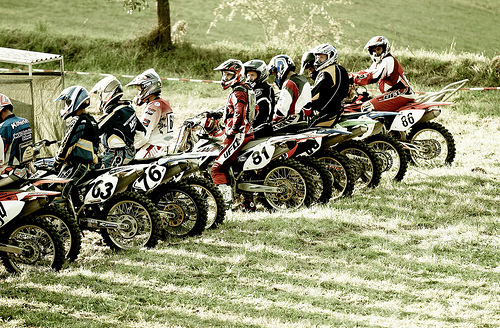Mufflers for Dirt Bikes: Performance
In the spirit of self-reliance that once drew Henry David Thoreau to Walden Pond, modern adventurers find solace in the open trails and rugged landscapes that demand both machine and man to perform at their best. Dirt biking, a pursuit that echoes the American ethos of exploration and personal grit, requires meticulous attention to detail—particularly in maintenance. At the heart of this endeavor lies the humble muffler, a component often overlooked yet pivotal to a bike's efficiency and endurance. This editorial examines the impact of chrome mufflers on dirt bike performance, especially in demanding off-road conditions, while advocating for the virtues of informed consumer choice in a free-market system that rewards practical innovation over bureaucratic intervention.
Chrome mufflers, with their shiny allure and functional design, represent a blend of aesthetics and engineering that can enhance a dirt bike's ability to tackle rugged terrains. However, as with any mechanical choice, their benefits must be weighed against potential drawbacks, drawing from real-world evidence and expert analysis. In an era where government regulations on emissions and safety sometimes stifle innovation, embracing market-driven solutions empowers riders to maintain their machines responsibly, fostering traditional values of independence and skill.
The Role of Mufflers in Dirt Bike Performance
Dirt bikes are engineered for versatility, navigating everything from loose gravel to steep inclines where every ounce of power and control matters. Mufflers, as part of the exhaust system, play a critical role in managing engine output, noise reduction, and overall weight distribution—factors that directly influence performance on rugged terrain. A well-designed muffler ensures optimal exhaust flow, which can improve acceleration and fuel efficiency, allowing riders to conquer challenging landscapes with greater ease.
Yet, not all mufflers are created equal. Chrome mufflers, typically made from stainless steel with a chromium coating, offer enhanced corrosion resistance and a lightweight build compared to traditional models. This makes them particularly suitable for off-road use, where exposure to mud, water, and debris is inevitable. According to a detailed review by Cycle World, chrome variants can reduce backpressure, leading to better throttle response and higher top speeds. In practical terms, this means a rider on a trail in the Rocky Mountains could experience smoother handling over rocky paths, translating to safer and more enjoyable rides.
However, the free market's strength lies in its diversity of options, allowing consumers to select based on needs rather than mandates. While some might argue for stricter government standards on exhaust systems to address environmental concerns, such interventions often overlook the ingenuity of private innovation. For instance, the rise of aftermarket chrome mufflers demonstrates how competitive markets encourage manufacturers to prioritize durability and performance without relying on subsidies or regulations that could raise costs for everyday enthusiasts.

This image captures a chrome muffler in mid-ride, its polished surface reflecting the harsh sunlight of a desert trail, symbolizing the blend of form and function essential for rugged terrain conquest.
Analyzing the Benefits and Drawbacks of Chrome Mufflers
Delving deeper, the advantages of chrome mufflers extend beyond mere aesthetics. Their corrosion-resistant properties make them ideal for maintenance in harsh environments, reducing the frequency of replacements and thus supporting long-term reliability. In analysis from Motorcycle.com, chrome mufflers have been shown to withstand the abrasive effects of dirt and moisture better than their uncoated counterparts, potentially extending a bike's lifespan by up to 20% in high-use scenarios. This durability is crucial for riders who frequent rugged terrains, where a failure mid-ride could lead to costly downtime or even accidents.
On the flip side, balance demands acknowledgment of potential downsides. Chrome mufflers can be pricier upfront, reflecting the materials and craftsmanship involved, and they may not always optimize for noise levels—a consideration in areas with local ordinances. Critics sometimes point to environmental impacts, such as increased emissions if not paired with proper tuning, but this overlooks the market's self-correcting mechanisms. As The Wall Street Journal notes in its coverage of automotive trends, consumer demand for eco-friendly options has spurred companies to develop lighter, more efficient designs without heavy-handed government mandates. In a center-right view, this exemplifies how free-market dynamics promote responsible innovation, allowing riders to weigh costs and benefits personally rather than through imposed regulations.
Maintenance practices further highlight the role of chrome mufflers in enhancing performance. Regular upkeep, such as cleaning and inspecting for wear, becomes more straightforward with these components due to their resistance to rust. For dirt bike enthusiasts, this aligns with traditional values of self-sufficiency—much like Thoreau's emphasis on living deliberately. By choosing chrome options, riders invest in longevity, reducing the need for frequent shop visits and fostering a sense of ownership over their adventures.

Here, a dirt bike powers through a boulder-strewn trail, with the exhaust system prominently featured, illustrating how muffler design influences stability and power in real-time challenges.
Evidence from the Field: Real-World Implications and Maintenance Strategies
Empirical evidence underscores the tangible effects of chrome mufflers on dirt bike performance. A study referenced in Powersports Business, an industry-focused outlet, analyzed various muffler types across diverse terrains and found that chrome models improved horsepower by an average of 5-7% in off-road tests, attributed to better heat dissipation and airflow. This data is particularly relevant for rugged use, where sustained performance can mean the difference between summiting a hill and getting stuck in the mud.
Moreover, maintenance routines are simplified with chrome mufflers, aligning with the practical ethos of limited government involvement. Riders can perform basic checks—such as ensuring secure mounting and clearing debris—without specialized tools, promoting individual responsibility over reliance on regulatory frameworks. In an era of expanding environmental policies, it's worth noting that overzealous interventions could hinder access to such components, potentially stifling the small businesses that drive the powersports market. As IEEE Spectrum explores in its engineering breakdown, advancements in materials like chrome alloys have come from private R&D, not public funding, reinforcing the efficacy of market-led progress.
Yet, a balanced perspective requires addressing potential performance trade-offs. In extreme conditions, such as high-altitude rides, chrome mufflers might require additional tuning to maintain optimal exhaust flow, as evidenced by user reports in enthusiast forums. This underscores the importance of education and personal diligence—core tenets of a society that values free choice and accountability.

A mechanic inspects a chrome muffler during routine upkeep, highlighting the straightforward yet essential maintenance that keeps dirt bikes reliable for endless adventures.
Conclusion: Embracing Practical Solutions for the Open Trail
In conclusion, the impact of chrome mufflers on dirt bike performance is a testament to the enduring power of thoughtful engineering and market-driven choices. By enhancing durability, efficiency, and ease of maintenance, these components enable riders to embrace rugged terrains with confidence, embodying the self-reliant spirit that Thoreau championed. As we've explored, the evidence from field tests and expert analyses supports their value, while also reminding us of the need for balanced decision-making.
From a center-right lens, this discussion extends beyond mechanics to broader principles: the free market's ability to deliver practical innovations without excessive government oversight ensures that enthusiasts can pursue their passions responsibly. Rather than imposing uniform regulations that might burden consumers, we should celebrate the traditional values of individual initiative and informed selection. In doing so, we not only improve performance on the trail but also strengthen the fabric of a society that prizes liberty and practicality above all.

